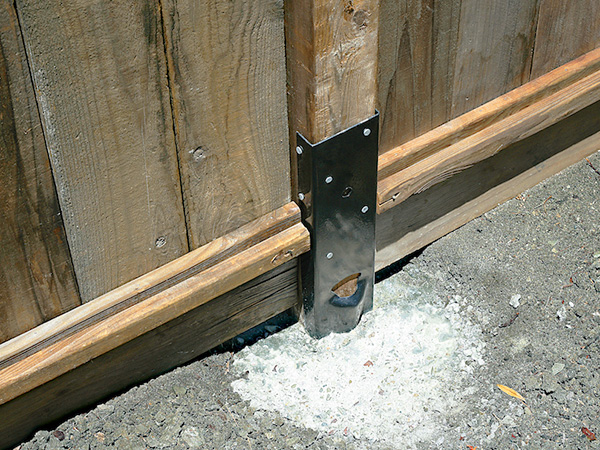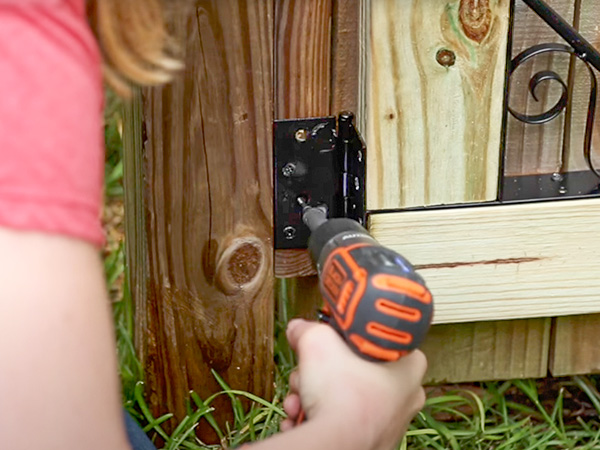

Get Fenced In: Fix Your Broken Fence
A broken fence with a rotting post, a leaning panel, or a sagging gate is not only an eyesore, but it could also pose a danger. You rely on your fence to keep your home secure whether that’s keeping the dogs in, giving your pool privacy, or marking a boundary line so taking care of an issue quickly is important. Here’s how to fix a broken wooden fence and keep it standing tall for years to come.
Assess the Damage
Here are a few things to keep in mind as you assess the damage to your fence and make a plan to repair it:
- Is it worth fixing or do I need a whole new fence? Repairing a fence can be more expensive and require more work when the damage is severe and affects a large area. In such cases, it may be more cost-effective and efficient to simply replace the entire fence.
- Do I know the permit requirements in my area? If you are simply replacing a post, a permit is most likely not required. Before moving the fence or doing extensive repairs, check with your city or county to avoid permit issues and potential fines.
- Have I spoken with my neighbor? If you share a fence with a neighbor, be sure you give them a heads up about the repair details and the timeline.

Fixing a Fence Solutions

- Damaged wood fence post. This is one of the most common fence issues. As posts are subjected to ground moisture, they tend to rot after years of being in the ground even if they are set in concrete. They can be fixed using one of these two different methods:
- Method One: The simplest fix is using a fence post repair bracket. If the post isn't fully rotted, these brackets will reinforce the posts, and you can install them into dirt or concrete post bases. Make sure to brace your fence first before installing the brackets. Hammer down a bracket on each side of the post between the post and the dirt/concrete. The bracket will hug the post. Screw down and remove the brace.
- Method Two: If you determine that you need to completely replace the post, you can do it like a puzzle piece.
- Brace the fence using two braces on either side of the post.
- Remove the old post by cutting the post a few inches deep on either side of the fence rails. Remove screws or nails as necessary.
- If the old post is set in concrete, you will need to break it up at the footing. Ensure the current hole is the correct depth, place the new post (checking for plumb), and pour in new concrete or add in stone for better drainage. Add screws or nails as necessary. Click here for more post-setting tips.


- A sagging fence gate. The easiest way to fix a gate that sags or drags is to use a no-sag kit. This is a series of brackets on new gate rails to make a new frame.
- Make sure you know the opening width of your gate. Measure the top and bottom rails accurately so you grab the correct kit.
- Your new gate rails should be 2x3, 2x4, or 2x6 boards cut one inch shorter than the width of the gate opening. Follow the specific step-by-step instructions included with your kit.
- Missing picket? If your fence looks like it’s missing a tooth, replacing the broken or missing pickets is a simple fix. Start by removing the old pickets with a drill or hammer. Then, measure the current picket size on your fence and cut your new picket to length. Line up your new picket with the rails and top of the other pickets. Screw/hammer in new nails or screws or reuse the old ones if they’re in good shape.
- Note: You can stain the new picket to match the weathered color of the old ones, if preferred before you attach it.
- A mildewed or dirty fence. With picket fencing, pressure washing away mildew, dirt, or other green and slimy messes will be the best way to get it looking clean. Choose a medium-angle nozzle for a higher spray area so you avoid damaging the wood on the fence with the force of a low-angle nozzle. After you start the washer, let it run for a few moments to get any air out of the line. If you have a stained fence, make sure you are about a foot away from the fence to avoid removing the stain. If your fence isn’t stained or painted, you can be closer. Make sure you spray in a consistent motion with the grain of the wood.
- Have digging animals? To stop a puppy from digging under a picket fence, put patio pavers around the edge while training the puppy. However, for a more permanent solution to keep your dog in or strays out, install chicken wire to the bottom of the fence and bury it a foot below ground. The chicken wire can even be bent into an “L” shape or bent “apron-style” like hog fencing.
General Fence Maintenance
Keeping up with the needs of your fence is best, so they don't become bigger problems down the road. Here are a few things to keep on top of and keep top of mind:
- Use caution when mowing or trimming your lawn. Consistently hitting your fence with your mower or especially your string trimmer, will cause damage to your fence.
- Keep away debris. Dead leaves and even garden mulch should be kept at least one foot away from the fence as it causes board decay over time. All plants including garden plants and trees need to be kept away to avoid growth disrupting the fence.
- Fix issues quickly. Leaving problems like mildew or a broken gate will weaken the fence leading to an early replacement.
- Protect your fence from the elements. Paint or stain your fence as needed to keep it looking new and protect it from damage.
Get the Best Fence in the Neighborhood with McCoy's
Ready to get started? Whether you need to fix a few pickets, clean off some mildew, or need to replace the whole shebang, McCoy’s is here to help. With our convenient delivery service, your materials can arrive in your backyard without you leaving your home. However, we still love seeing you so stop by if you need some fence advice for just want to browse fencing options.
